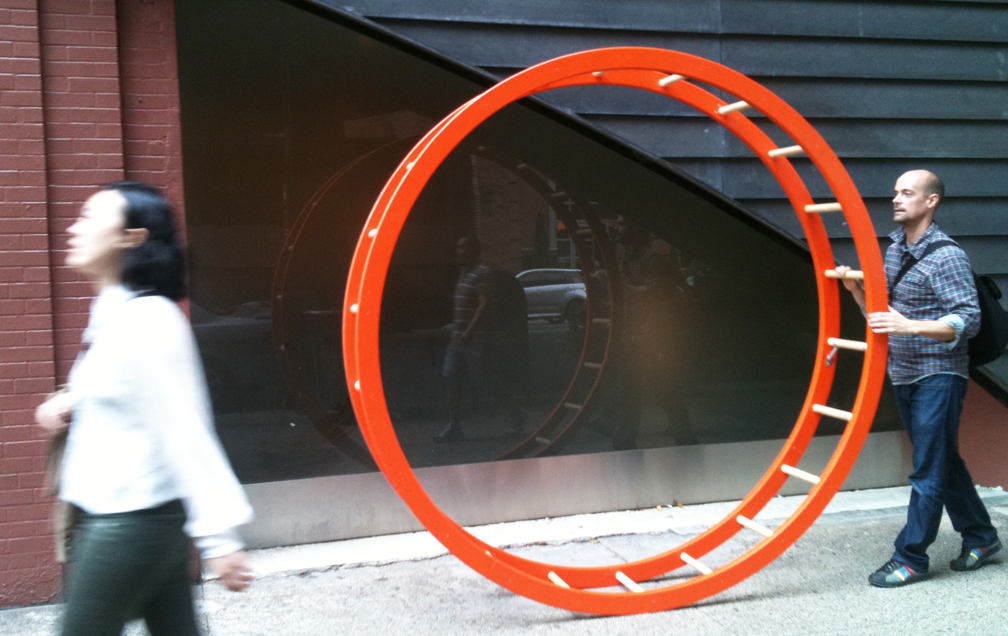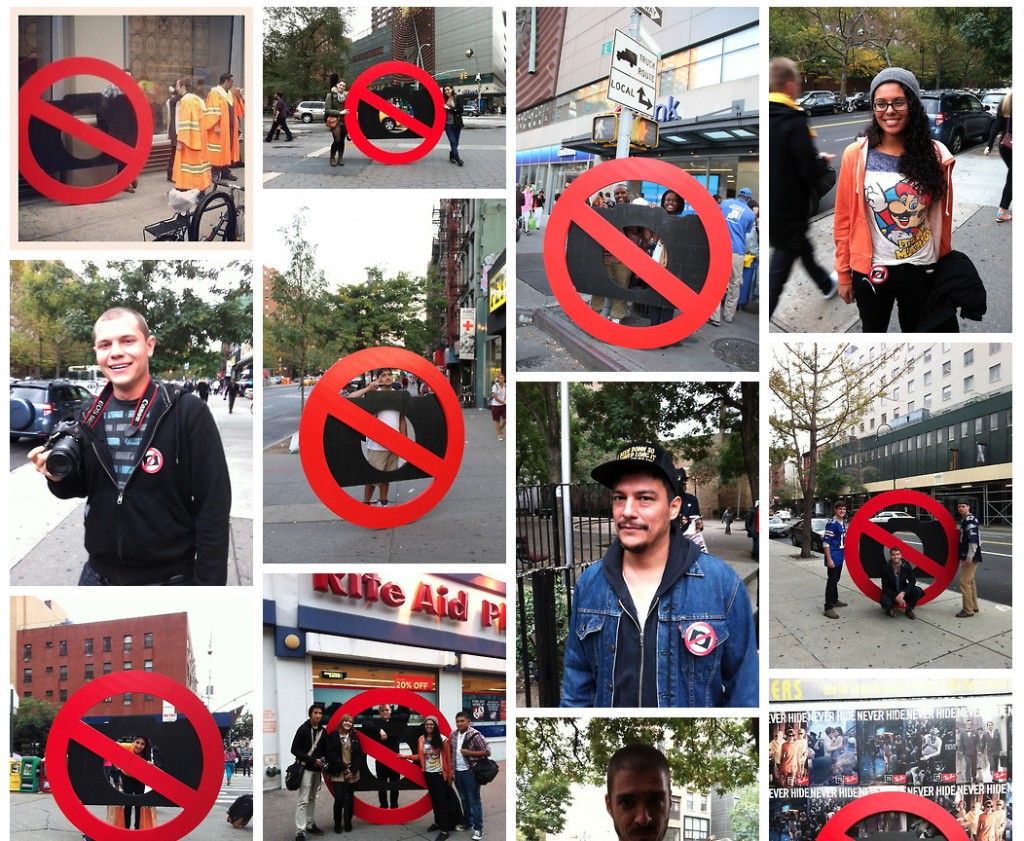
Paul: As part of the 8th annual street festival Art In Odd Places, I walked along 14th Street in New York City holding an enlarged seven-foot “no photos” symbol that implies a prohibition on photography and questions the constant surveillance of public spaces. I invited pedestrians to have their photo taken with the sculpture, thereby subverting the act the sculpture denies.
Can you talk about the performance you did as part of AiOP MODEL?
Steve: My project titled the “Reciprocal Ladder” involved rolling, pushing, and pulling a large circular ladder on the sidewalks and through other public spaces along the length of 14th Street.

Paul: What struck me about your project was the physical similarity of its scale to my own sculpture. But your work functioned differently than mine. While I was creating an ironic gesture and interaction, your work seemed to function more as metaphor for social hierarchies and success. Your ladder doesn’t seem to be used for actual climbing but to address the rat race. Your “Ladder of Success” seems to reflect the rat race, both in its physicality and in the labor of your rolling it around all day? Can you talk more about the mobility and social hierarchies in your piece?
Steve: I really liked seeing the similarities that you and I had with our projects in relationship to the scale, color, and even the awkwardness of moving these somewhat unwieldy physical forms through the crowded blocks of 14th Street.
That’s an interesting point that you bring up; I hadn’t thought about the project in relationship to the idea of the “rat race,” although I’m certainly interested in any range of associations that may come to mind. Initially, what got me thinking about a project that could be moved horizontally through space was seeing the organizational structure put in place during the Occupy Wall Street protests. Attending some of the general assemblies in Zuccotti Park, along with some of the committee meetings happening simultaneously, I was struck by the commitment to keep the organizational structure transparent and horizontal with the various affinity groups feeling empowered and encouraged to make decisions and take action in ways that they saw fit — as opposed to a top-down type of organizational structure where an agenda would be determined by one layer of management and then carried out by another.

Similarly, I’m also interested in how ideas of progress and failure can be measured. What types of criteria inform these evaluations? Who determines these priorities? By rethinking the physical structure of a ladder that is typically climbed from the bottom up or top down, my hope is to be able to also rethink priorities and social organizational systems that we participate in.
It’s interesting how many of your projects use humor and irony in a subtle way and I really like how your “no photos” project is engaging viewers through the act of negation. There is something very funny happening in terms of the contradictions taking place here. How did you structure the interactions on the street? Did it happen organically? Or were you directly engaging people by asking them to take a picture?
Paul: I realized very quickly that I had to stop to get people to engage with me and the sculpture. I ended up stopping at every intersection and waiting/creating a moment that someone would want to capture. Some people merely snapped photos and moved on while quite a few took photos and crossed the street to ask what I was doing. Whenever anyone stopped I would discuss the project and ask if they wanted to be photographed with it. I often used their phones as well as my own to photograph them.

As part of my performance, I passed out buttons with the same “no photos” logo on it; people gravitated to them and quickly put them on. This allowed them to embody the idea of the project. Depending on the person, the button became either a very political denial of taking their photo or a playful one. I feel this allowed the idea in the work to be carried on outside of the performance, and hopefully spark more conversations.
In your work, climbing the social ladder takes on a new meaning. Can you talk about what kind of interactions and responses you received from viewers and businesses in the various communities that make up 14th street?
Steve: I found the range of responses varied depending on the neighborhood and time of day, and I was reminded of the ubiquity of cameras in our day to day experience. Tourists on the west side were quick to bring out their cameras, while residents on the east side were more interested in stopping to talk for a minute. In general, people seemed curious and asked a lot of questions, which set up a dialogue I was happy to have.
Many of your past projects use social interactions as a focal point and your “no photos” project continues along these lines. What factors led you to address the issue of surveillance in public space in this project?

Paul: I feel we are living in a very precarious moment where everyone has the ability to surveil everyone one else. Anonymity is quickly fading, especially as we get closer to facial recognition software becoming more accurate. We live our lives now in a very public way.
In this project, I wanted to address surveillance in a way that wasn’t super serious or heavy handed. I like that it’s open enough for viewers and participants to bring their own views on the idea of not taking photos to the work. There are many contradictions the piece has which, to me, brings out the contradictions we face constantly. Museums don’t allow you to photograph certain works, while often missing the irony of their taking video surveillance. You aren’t allowed to photograph police, but they are allowed to photograph you.
Steve: There is a serious, unsettling, and lop-sided power dynamic that your project is drawing attention to in a seemingly lighthearted way. The notion that institutions, whether they are museums or police departments, have rights and abilities to surveil the public, but the public doesn’t have the ability to easily determine when, or by who, they are being watched by, presents a somewhat frightening Orwellian reality that we are confronted with—addressing these issues through humor presents an extremely engaging way to raise awareness.
Do you have any plans to continue this series or re-stage your performance in any other locations? During your performances, did you come across any other artists or projects from the AiOP festival? From your perspective, how do you think being a part of the larger AiOP festival informed the viewers responses to your project?
Paul: I think being a part of AiOP gave me a platform for the performance and added a bit of credibility to a performance that just could have been seen as a spectacle. I didn’t come across too many other AiOP performances, but I believe that was partly to due to the weather on the second day. When I did come across them, I tended to keep a distance so as not to disturb or interrupt their performances.
I will be moving to Washington D.C. in May of next year and plan to stage a few performances of Please No Photos there, hitting all the national landmarks.
Do you have any plans to continue or re-stage your performance outside of AiOP?
Steve: I agree, the AiOP festival provided an interesting platform that viewers were excited to learn about; I found this to be a tangible benefit that helped to significantly validate the efforts of the artists. Once things got going and word began to spread along 14th Street, many people seemed to be on the lookout for unexpected things to be occurring in their otherwise familiar environments.
I’m certainly interested in thinking about the context that locations with different histories, geographies, and patterns of traffic have on the experience of the piece. Most immediately, in November, the project will be included in an exhibition at the Bronx Art Space.
Be sure to keep up with Steve Rossi and Paul Shortt!


One Trackback
[…] is a recent interview with Paul about the performance: http://artinoddplaces.org//after-aiop-model-artists-steve-rossi-and-paul-shortt-discuss-their-exp… Share this:ShareTwitterFacebookGoogle […]